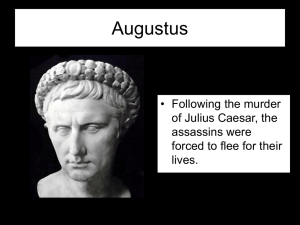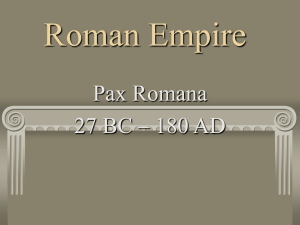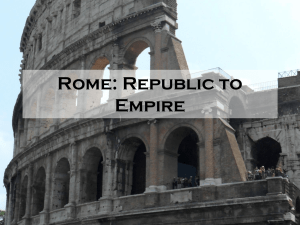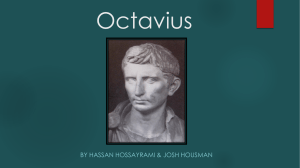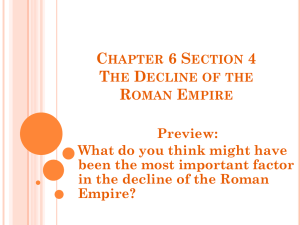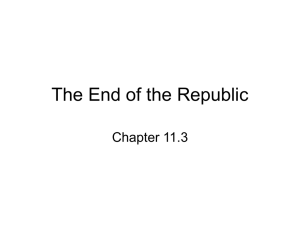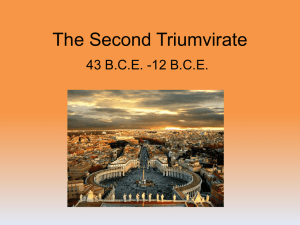C6.2 - From Republic to Empire - World History and Honors History 9
advertisement
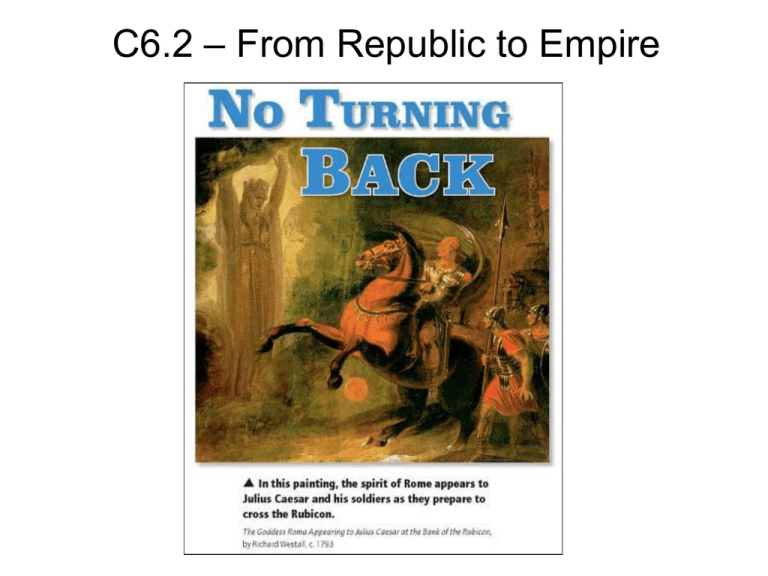
C6.2 – From Republic to Empire C6.2 - From Republic to Empire Main Idea Governmental and social problems led to the end of the Roman Republic and the creation of a new form of government. Objectives • What problems did leaders face in the late Roman Republic? • How did Rome become an empire? • What helped tie the Roman empire together during the Pax Romana? I. Problems in the Late Republic By 133 BC, Rome was the supreme power in the Mediterranean world I. Problems in the Late Republic Political and social revolution began because of tensions between social classes A. Social Unrest 133 BC - The Gracchi, brothers Tiberius and Gaius Gracchus, tried to resolve problems TIBERIUS GRACCHUS (c.163-133 BC) GAIUS GRACCHUS (c.153-121 BC) A. Social Unrest Soldier/farmers returned from the Punic Wars to find their homes and farms destroyed A. Social Unrest The Gracchi instituted public reforms such as redistributing public land to the farmers Tiberius and Gaius Gracchus with their mother, Cornelia A. Social Unrest Both were elected tribunes, both were assassinated after angering the Senate Death of Tiberius Gracchus by members of the Roman Senate, 133 BC Death of Gaius Gracchus, 121 BC A. Social Unrest Their deaths marked a turning point – violence, not law, began to control politics Cornelia Refuses the Crown of the Ptolomai The daughter of Scipio Africanus and mother of Tiberius and Gaius Gracchus refuses the crown of the King of Egypt and his marriage proposal. A. Social Unrest 91 BC - the Social War resulted in Rome’s allies becoming Roman citizens This map depicts the landscape of Italy during the period of the Social War and portrays select sites relating to the history of Rome B. The Military in Politics Generals created loyal private armies and forced the Senate to do their bidding Gaius Marius 157– 86 BC Lucius Cornelius Sulla 138-78 BC B. The Military in Politics 107 BC - Gaius Marius elected consul; eliminated army’s restrictions and enlisted anyone As counsel, Gaius Marius decreed that the eagle would be the symbol of the Senate and People of Rome B. The Military in Politics 88 BC - Sulla became consul; Marius tried to prevent Sulla from taking military command B. The Military in Politics Sulla marched on Rome with his legion, won a civil war, and became dictator Sulla Fights his Way into Rome II. Rome Becomes an Empire A. The First Triumvirate 60 BC - Caesar, Gnaeus Pompey and Licinius Crassus, formed the First Triumvirate Julius Caesar 100 - 44 BC Gnaeus Pompey 106 - 48 BC Licinius Crassus 115 BC – 53 BC A. The First Triumvirate Crassus died; Caesar defeated Pompey in a civil war; named dictator for life in 44 BC Julius Caesar and the Crossing of the Rubicon A. The First Triumvirate 44 BC - Caesar instituted popular reforms; Fearing he wanted to be king, Senators murdered him March 15th (the Ides of March) The Assassination of Caesar March 15th, 44 BC “Beware the Ides of March” “Et tu, Brute?” B. The Second Triumvirate 43 BC - Octavian, Marc Antony, and Lepidus seized power; formed the Second Triumvirate Octavian 63 BC - AD 14 Marc Antony 83 BC – 30 BC Lepidus 90 BC - 13 BC B. The Second Triumvirate Lepidus forced out; Antony and Octavian each governed half the empire B. The Second Triumvirate 31 BC - Civil war between Octavian and Antony; Octavian defeated Antony and Egypt’s Cleopatra The Battle of Actium B. The Second Triumvirate Cleopatra, Antony committed suicide; Octavian controlled Rome; republic ended Antony and Cleopatra C. From Octavian to Augustus Octavian called himself princeps, government called Principate; new political order emerged – the empire Augustus (63 B.C. – AD 14) First Roman Emperor (27 BC - AD 14) “He subjected the whole wide earth to the rule of the Roman people” C. From Octavian to Augustus 27 BC - Senate gave Octavian title of Augustus, “the revered one” Birth name: Gaius Octavius Thurinus Name as Emperor: Gaius Julius Caesar Augustus D. The Augustan Age Ruled 40 years, power shared with Senate; conquests expanded the empire and brought peace D. The Augustan Age Life improved; period of cultural creativity, greatest writers in Roman history – Horace, Ovid, Livy, and Virgil E. The Emperors AD 14 - Augustus died; empire ruled by Caesar’s relatives next 54 years – the JulioClaudian Emperors E. The Emperors Abilities varied: Tiberius - good soldier and ruler; Caligula - brutal, mentally unstable; Nero, last Julio-Claudian - committed suicide in AD 68 Tiberius (A.D. 14-37) Caligula (37 to 41) Nero (54-68 A.D.) E. The Emperors After Nero, civil wars raged; four military leaders ruled in AD 69; last was Vespasian Titus Flavius Caesar Vespasianus Augustus (AD 9 – AD 79 E. The Emperors 69 to 96 AD - Vespasian re-established order; stability returned under the Flavians - Vespasian and his two sons The Flavian family, Vespasian and his sons Titus and Domitian, depicted in The Triumph of Titus E. The Emperors AD 96: reign of the Good Emperors began – five rulers who governed Rome almost a century The Five Good Emperors - Nerva, Trajan, Hadrian, Antoninus Pius, and Marcus Aurelius E. The Emperors Empire grew under the Good Emperors; reached limits of expansion under Trajan Aureus issued by Trajan to celebrate the conquest of Parthia E. The Emperors Trajan added Romania, Armenia, Mesopotamia, and the Sinai Peninsula E. The Emperors Hadrian thought empire too large, withdrew from the east; built fortifications as guard against invasions Hadrian's Wall in northern England III. The Pax Romana 27 BC to AD 180 – Period of the Pax Romana: stable government, strong legal system, widespread trade, and peace A. Government Government strongest unifying force in empire: maintained order, enforced laws, defended frontiers A. Government Empire divided into provinces ruled by governors appointed and monitored by Rome B. Laws, Trade, Transportation Law unified the empire; specified crimes and penalties; applied to everyone in empire - the “Rule of Law” B. Laws, Trade, Transportation Agriculture remained primary occupation; tenant farmers began replacing slaves on large farms B. Laws, Trade, Transportation Manufacturing increased; produced everything from cheap pottery to world’s finest goods Ancient Roman drinking vessels, bowls and jars Ancient glassware from the Roman era B. Laws, Trade, Transportation Imported grain, meat, raw materials from provinces; Rome and Alexandria became commercial centers B. Laws, Trade, Transportation Commercial activity possible because of empire’s location and extensive (about 50,000 mile) road network
